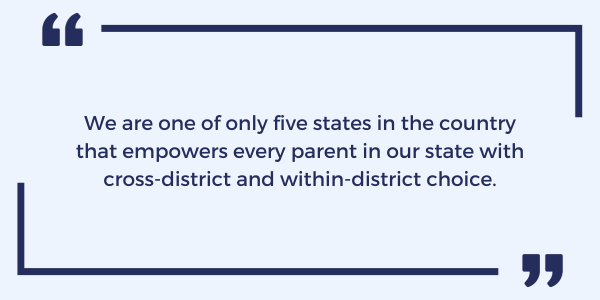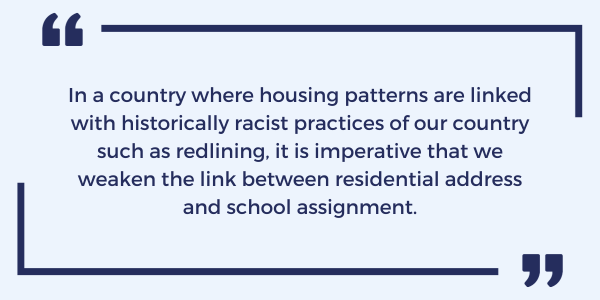
For more than three decades, Colorado has led the nation in embracing school choice and providing many different public school options for families.
Colorado was one of the first states in the country to pass a statewide charter school law, and today 16% of students attend charter schools, the second highest proportion in the country. We were also one of the first states to embrace virtual learning choices, and currently have 30,000 students enrolled in online classes.
More recently, we passed the Innovation Schools Law, allowing district schools to have more flexibility if they choose to, and over 50,000 students attend innovation schools across Colorado. Combined, more than one out of every five students in Colorado attends a charter, innovation, or virtual school.
While we are proud that families have different school models to choose from, one aspect of public school choice that we in Colorado take for granted but is often overlooked is cross-district choice among traditional schools, often called “open-enrollment.”
Since 1994, all Colorado students have had the ability to choose a school within or outside of their district, subject to available space, and most importantly, districts cannot opt-out. We are one of only five states in the country that empowers every parent in our state with cross-district and within-district choice.

We also explicitly prohibit charging students tuition if they do not live within the district, something half of all states in the country still allow. Districts also are not allowed to inquire about a student’s special needs before they are accepted. Last year, nearly 90,000 students (over 12% of students) attended a traditional district school or district-authorized charter school outside of their school district.
A 2022 research study found that Colorado was one of only nine states with model cross-district enrollment policies. But even our open-enrollment system is far from perfect and we still have work to do to make it better for families. For example, there is room to improve transparency around reporting on school capacity to ensure families have the best possible information when choosing where to send their kids. Families without means of transportation are also effectively precluded from open-enrollment, and families who have children with special needs still feel like they do not get a fair chance at enrolling in a school that meets their needs outside of their district.

In a country where housing patterns are linked with historically racist practices of our country such as redlining, it is imperative that we weaken the link between residential address and school assignment. Strong open-enrollment policies like the one we have in Colorado, supplemented by strong charter, virtual, and innovation laws, can decouple the link between school assignment and home address.
Rather than push private options which often subsidize wealthy families, subsidize religious education, and are not accountable to rigorous standards, states should look to Colorado as a model on how to maximize public school options for all.
If you want to learn more about the school choice infrastructure in Colorado, please access the materials below:
1) School Choice Law
2) Protections for students with disabilities
3) Charter Schools Law
4) Online Schools Law
5) Innovation Schools Law
6) Charter School Funding Equity Law
You can download a PDF version of this post here.